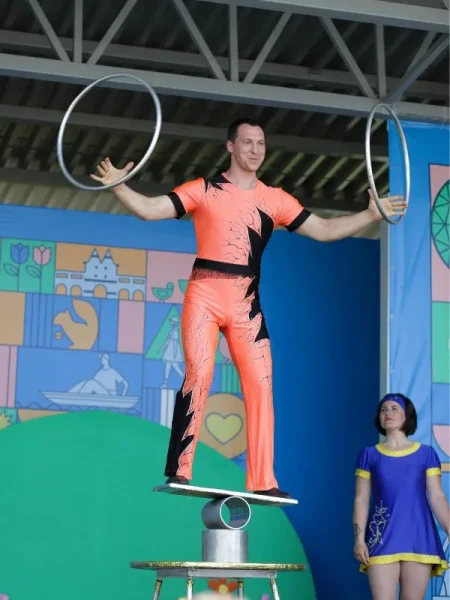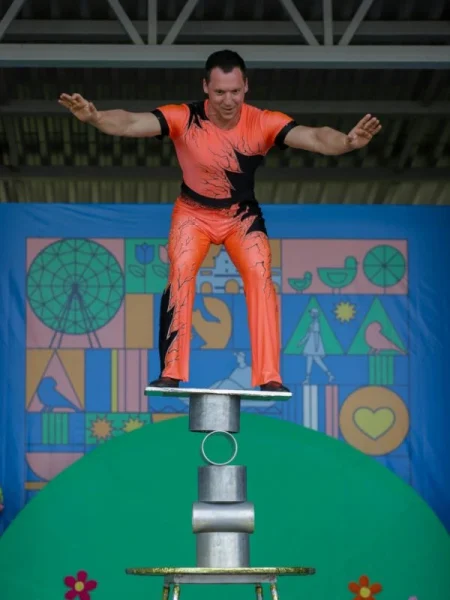Rolla Bolla 101
A wobbly introduction to one of circus’s most underrated balancing acts
First Things First: What Is a Rolla Bolla?
At its core, Rolla Bolla is just a board balanced on a rolling cylinder. That’s it.
Simple, right? Well – like most things that seem easy – it’s anything but.
The goal? Stand, balance and maybe even do tricks on that rolling plank without it shooting out from under you like a cartoon banana peel. It’s part circus skill, part coordination challenge and part emotional rollercoaster. (That last one? That’s not a joke.)
You’ve probably seen it in action – maybe on a street corner, in a Cirque du Soleil act or in some wildly tense moment on America’s Got Talent. But you don’t have to be a pro performer to give it a shot. These days, more and more people are adding Rolla Bolla to their training – whether for balance, core control or just because it looks cool.
Who’s Uses a Rolla Bolla?
Honestly? Anyone curious about balance.
Performers love it, obviously – juggling on a moving platform gets attention. But it’s also caught on with skaters, climbers, fitness people and anyone who wants to train stability in a more dynamic, less boring way.
And for people who’ve done a bit of slackline, board sports or balance tools like Bosu balls – it feels like a natural next step. Slightly scarier. But way more satisfying.
The Anatomy of a Rolla Bolla (Spoiler: It’s Just Two Things)
You’ve got:
The Board: Usually wood, flat and strong enough to handle your full body weight plus a few hops. Length and width vary, but it’s typically 2 to 3 feet long.
The Roller (a.k.a. Cylinder): This is the thing that moves. PVC pipe, aluminum or even wood. Smooth enough to roll but not so slick that it flies.
That’s it. No screws. No glue. Just physics.
Some setups include “stoppers” underneath the board so it doesn’t completely shoot off the roller when you’re learning. These are optional, but trust me – if you’re new, you’ll want them.
How Hard Is Rolla Bolla, Really?
Let me be straight with you: The first time you step on a Rolla Bolla, you’ll probably feel (and look) like a baby deer on a frozen trampoline.
There’s a weird blend of stillness and movement that your brain isn’t used to. Your muscles will twitch. Your knees might shake. You might squeak. All normal.
But here’s the trick – balance isn’t about freezing. It’s about adjusting. Constantly. Subtly. You’re always almost falling, and your body’s just catching up. Once you get used to that rhythm, it starts to feel less terrifying. And more like surfing on land.



Starting Out Without Faceplanting the Floor
Here’s how to dip your toes in without bruising your ego – or your shins.
Find a safe space:
– Carpeted floors or padded mats
– A wall, table or friend nearby to catch you
– Something soft nearby (just in case)
Start small:
– Place the roller under the board, dead center
– Use a wall or spotter for support
– Step one foot on first – heel to ball of foot on the board
– Then bring the second foot up slowly
Now breathe. Don’t stare at your feet. Eyes forward, slight bend in your knees. Let the board roll a little side to side. Don’t fight it – just go with it.
Why Bother Learning Rolla Bolla Anyway?
Good question. Because on the surface, it’s “just balancing.” But here’s what Rolla Bolla actually trains:
– Core strength (real-deal core—not just abs-for-Instagram core)
– Micro-adjustment awareness (a.k.a. “Oh hey, I moved my pinky toe and stayed up”)
– Ankle and knee stability
– Mental focus and calm under pressure
– Balance under movement, not stillness
It’s dynamic, awkward and a little chaotic. Which is kind of the point. Life doesn’t happen in stillness, right?
Circus Cred: Rolla Bolla in Performance
If you’re picturing someone just standing there balancing, you’re missing the magic.
Pro performers take this thing to extremes. We’re talking:
– Handstands on the board while it moves
– Stacks of multiple boards and rollers (yeah, like a crazy Jenga tower)
– Juggling while balancing
– Jumping from board to board
– Spinning the board while balancing (which is as wild as it sounds)
Rolla Bolla acts are often tense, playful and designed to make the audience gasp. That slow, controlled teeter? That’s choreographed suspense – like watching a glass of water about to tip but never quite spilling.
Training Tips (From People Who’ve Fallen – A Lot)
You can learn this faster than you think—if you practice smart. Here’s what helps:
– Short sessions: Your stabilizer muscles burn out quickly. Do 5–10 minutes at a time.
– Barefoot or grippy shoes: Slippery soles = disaster.
– Film yourself: It’s hard to feel subtle weight shifts. Watching helps.
– Use stoppers: Until you’re confident, they’ll help keep the board from zipping away.
– Progression matters: Don’t jump to tricks until you’ve mastered standing still, moving gently side-to-side and staying calm when things shift.
And don’t beat yourself up. Falling is part of the process. Falling well is a skill too.
The Mind Game: What’s Going On in Your Head
There’s this strange thing that happens when you’re trying to balance and you want to control everything. Your body tenses. You grip the board with your toes. You try to “hold” your balance with sheer will.
But that backfires.
The key is relaxed control. Tuned-in, but not stiff. It’s like learning to float in water. You can’t force it. You’ve got to trust the feedback. Adjust, breathe, soften. Your brain hates that at first. But once it catches on, you’ll stop fighting gravity – and start dancing with it.
Level Up: Beyond Just Standing
Once you’ve got your sea legs, here are a few fun next steps:
– Shifting weight side to side—controlled, like surfing
– Squats on the board (start partial, knees bent)
– Turn the board 90° on the roller and balance lengthwise (yes, it’s harder)
– Prop tricks: Add juggling or spinning clubs
– Stack another board (not kidding – start low, but you’ll see people go 4–5 high)
Rolla Bolla becomes your playground once you’ve got the basics down. The only limit? Imagination. (And, okay, physics.)
Where to Learn and Who to Watch
If you’re itching to see this in motion or follow someone legit:
Instagram handles: @sergeytimofeev (mad stacks), @circuswa (great beginner content), @remi.martin.official (Cirque-level insane)
YouTube tutorials: “How to Rolla Bolla for Beginners” by Circus Arts Australia
Circus schools: Look for community-based programs in your area—places like SANCA (Seattle), NECCA (Vermont) or Circus Center (San Francisco)
Street festivals or circus shows: Honestly, the best Rolla Bolla demos are often live. The tension is different when the audience is holding their breath with you.
Final Thoughts: Why This Wobbly Plank Might Be Worth Your Time
You know what? There’s something special about learning to balance on something that literally doesn’t want you there.
It teaches patience. Control. Humility. Focus. And this weird, unexpected confidence – like, “If I can balance on this rolling tube, maybe I can handle whatever else today throws at me.”
Also – it’s just fun. Ridiculous, humbling, hilarious fun. You wobble, you recover. You fall, you try again. It’s physical comedy meets circus training meets mindfulness.
And all you need is a board, a roller and the guts to step on.
So… Ready To Roll?
Because honestly, that board isn’t going to balance itself.
